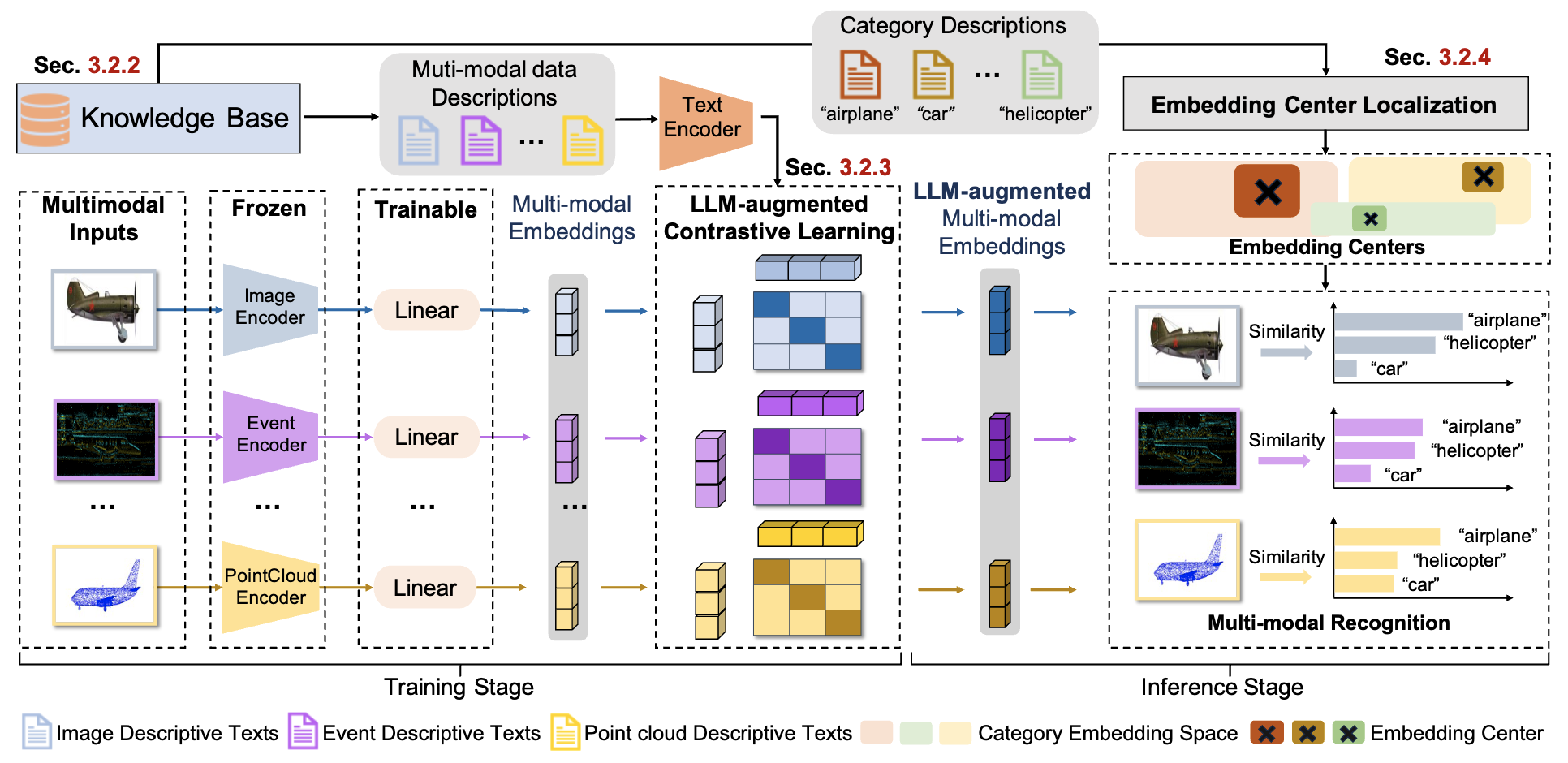The source code for "UniBind: LLM-Augmented Unified and Balanced Representation Space to Bind Them All" (CVPR 2024).
- Clone the repository:
git clone https://github.com/qc-ly/UniBind cd UniBind - Create an environment:
conda create -n unibind python==3.9 conda activate unibind - Install the required packages:
conda install pytorch==1.13.0 torchvision==0.14.0 torchaudio==0.13.0 pytorch-cuda=11.6 -c pytorch -c nvidia conda install cartopy pip install -r requirements.txt
-
Download the pre-trained weights from [link] to
./ckpts/ -
Download the centre embeddings from [link] to
./centre_embs/ -
Inference for 6 modalities: We have provided some sample data in
./assets/to quickly see how UniBind works.For image modality:
CUDA_VISIBLE_DEVICES=0 python demo_for_image.py
Output:
The categories are: ['folding chair', 'Shetland sheepdog, Shetland sheep dog, Shetland']For audio modality:
CUDA_VISIBLE_DEVICES=0 python demo_for_audio.py
Output:
The categories are: ['airplane', 'car_horn']For video modality:
CUDA_VISIBLE_DEVICES=0 python demo_for_video.py
Output:
The categories are: ['vehicles/autos', 'education']For point cloud modality:
CUDA_VISIBLE_DEVICES=0 python demo_for_point.py
Output:
The categories are: ['airplane', 'car']For thermal modality:
CUDA_VISIBLE_DEVICES=0 python demo_for_thermal.py
Output:
The categories are: ['person', 'background']For event modality:
CUDA_VISIBLE_DEVICES=0 python demo_for_event.py Output:
The categories are: ['gerenuk', 'sea_horse']
-
Download the pre-trained weights from [link] to
./ckpts/ -
Download the centre embeddings from [link] to
./centre_embs/ -
Process the datasets in the following form:
|----|datasets/ |----|---|ImageNet-1k/ |----|---|---|train_dataset/ |----|---|---|---0.jpg |----|---|---|---1.jpg |----|---|---|---... |----|---|---|eval_dataset/ |----|---|---|test_dataset/ |----|---|---|train_data.json |----|---|---|eval_data.json |----|---|---|test_data.json |----|---|... |----|---|ESC-50/ |----|---|---|... -
The data format of the
test_data.jsonis shown as follows:[ { "data": data_file_name, "label": label, } ... ] -
Running for zero-shot setting.
cd scripts bash zero_shot.sh
-
Download the pre-trained weights from [link] to
./ckpts/ -
Download the centre embeddings from [link] to
./centre_embs/ -
Generate the multi-modal data descriptions for your dataset via LLaMA-Adapter and GPT-4. Here we show the demo code for generating descriptions via LLaMA-Adapter:
import ImageBind.data as data import llama from tqdm import tqdm import pickle import json import torch llama_dir = "llama/llama_model_weights" model = llama.load(LLaMA_weight_path, llama_dir, knn=True) model.eval() model.cuda() descriptions = [] video_data_list = [] with open(video_meta_data_path, 'r') as f: data = json.load(f) for line in data: video_data_list.append(line['video']) for i, video in enumerate(tqdm(video_data_list)): inputs = {} video_data = data.load_and_transform_video_data([video_path+video], device='cuda') inputs['Video'] = [video_data, 1] with torch.no_grad(): results = model.generate( inputs, [llama.format_prompt(f"Describe the video.")], max_gen_len=77 ) result = results[0].strip() descriptions.append(result)
-
Process the datasets in the following form:
|----|datasets/ |----|---|ImageNet-1k/ |----|---|---|train_dataset/ |----|---|---|---0.jpg |----|---|---|---1.jpg |----|---|---|---... |----|---|---|eval_dataset/ |----|---|---|test_dataset/ |----|---|---|train_data.json |----|---|---|eval_data.json |----|---|---|test_data.json |----|---|... |----|---|ESC-50/ |----|---|---|... -
The data format of the
train_data.jsonis shown as follows:[ { "data": data_file_name, "description": descriptive_text, "label": label, } ... ] -
The data format of the
eval_data.jsonandtest_data.jsonis shown as follows:[ { "data": data_file_name, "label": label, } ... ] -
Running for fine-tune setting.
cd scripts bash fine_tune.sh
Our codes are built on open-source codes, thanks to the following projects:
Thanks for their outstanding works and open-source!
If you find this repository useful, please consider giving stars ⭐ and citations
@inproceedings{girdhar2023imagebind,
title={Imagebind: One embedding space to bind them all},
author={Girdhar, Rohit and El-Nouby, Alaaeldin and Liu, Zhuang and Singh, Mannat and Alwala, Kalyan Vasudev and Joulin, Armand and Misra, Ishan},
booktitle={Proceedings of the IEEE/CVF Conference on Computer Vision and Pattern Recognition},
pages={15180--15190},
year={2023}
}
@article{guo2023point,
title={Point-bind \& point-llm: Aligning point cloud with multi-modality for 3d understanding, generation, and instruction following},
author={Guo, Ziyu and Zhang, Renrui and Zhu, Xiangyang and Tang, Yiwen and Ma, Xianzheng and Han, Jiaming and Chen, Kexin and Gao, Peng and Li, Xianzhi and Li, Hongsheng and others},
journal={arXiv preprint arXiv:2309.00615},
year={2023}
}
@article{zhang2023llama,
title={Llama-adapter: Efficient fine-tuning of language models with zero-init attention},
author={Zhang, Renrui and Han, Jiaming and Zhou, Aojun and Hu, Xiangfei and Yan, Shilin and Lu, Pan and Li, Hongsheng and Gao, Peng and Qiao, Yu},
journal={arXiv preprint arXiv:2303.16199},
year={2023}
}
@article{han2023imagebind,
title={Imagebind-llm: Multi-modality instruction tuning},
author={Han, Jiaming and Zhang, Renrui and Shao, Wenqi and Gao, Peng and Xu, Peng and Xiao, Han and Zhang, Kaipeng and Liu, Chris and Wen, Song and Guo, Ziyu and others},
journal={arXiv preprint arXiv:2309.03905},
year={2023}
}
@article{lyu2024unibind,
title={UniBind: LLM-Augmented Unified and Balanced Representation Space to Bind Them All},
author={Lyu, Yuanhuiyi and Zheng, Xu and Zhou, Jiazhou and Wang, Lin},
journal={arXiv preprint arXiv:2403.12532},
year={2024}
}
If you have questions, suggestions, and bug reports, please email:
lvyuanhuiyi@foxmail.com
